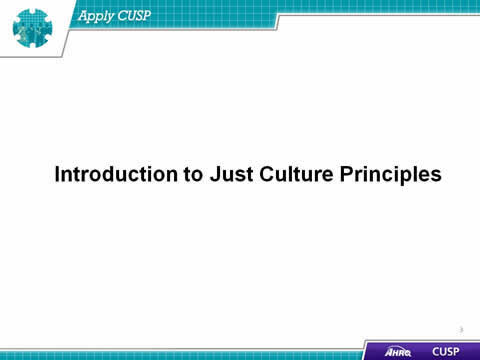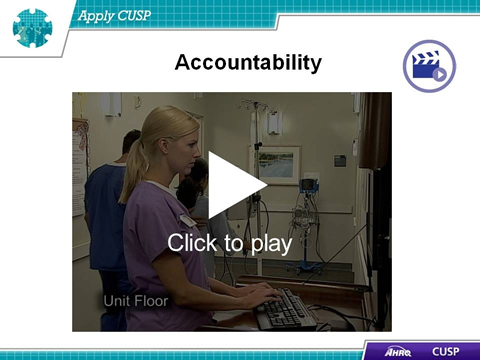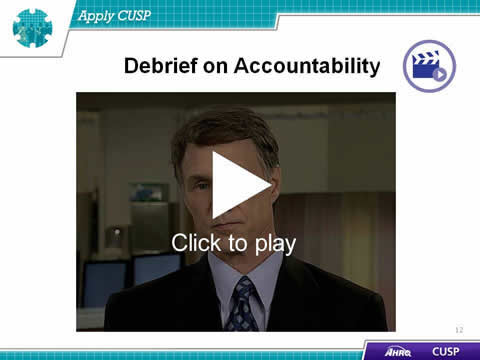Presentation Slides
CUSP Toolkit, Apply CUSP
Note: Slide content is presented below each of the images.
Contents
Slide 1. Cover Slide
Slide 2. Learning Objectives
Slide 3. Introduction to Just Culture Principles
Slide 4. Understand Just Culture
Slide 5. Just Culture
Slide 6. Understanding Risk and Human Behavior
Slide 7. Managing Error and Risk
Slide 8. Systems and Behaviors Work Together To Improve Outcomes
Slide 9. Accountability
Slide 10. Engineering System Design to Support Behavior Choices
Slide 11. Leadership Team's Role in Applying Just Culture Principles
Slide 12. Debrief on Accountability
Slide 13. CUSP Toolkit Modules
Slide 14. CUSP Toolkit Review
Slide 15. Assemble the Team
Slide 16. Keys to Assembling the Team
Slide 17. Engage the Senior Executive
Slide 18. Keys to Engaging the Senior Executive
Slide 19. Understand the Science of Safety
Slide 20. Keys to Understanding the Science of Safety
Slide 21. Identify Defects Through Sensemaking
Slide 22. Keys to Identifying Defects Through Sensemaking
Slide 23. Implement Teamwork and Communication
Slide 24. The Keys to Effective Communication
Slide 25. Summary
Slide 26. References
Slide 1. Cover Slide
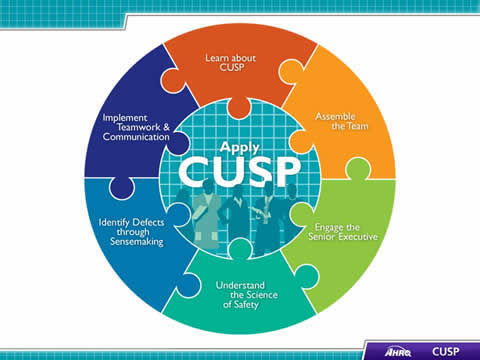
Image: CUSP Toolkit logo.
Slide 2. Learning Objectives
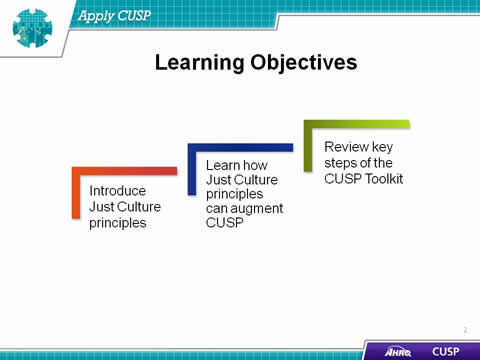
- Introduce Just Culture principles.
- Learn how Just Culture principles can augment CUSP.
- Review key steps of the CUSP Toolkit.
Slide 3. Introduction to Just Culture Principles
Slide 4. Understand Just Culture
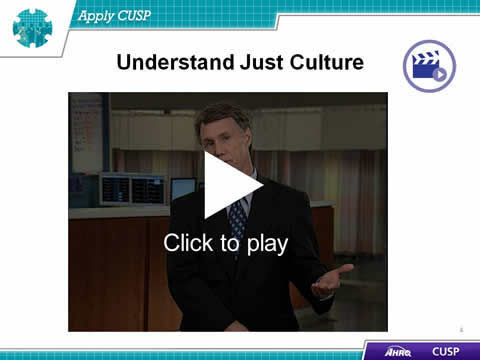
Vignette still.
Click to play.
Slide 5. Just Culture1
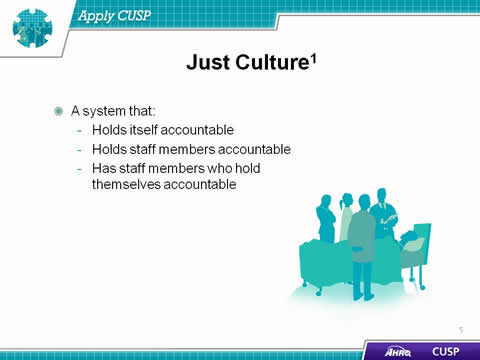
- A system that:
- Holds itself accountable.
- Holds staff members accountable.
- Has staff members that hold themselves accountable.
Slide 6. Understanding Risk and Human Behavior1
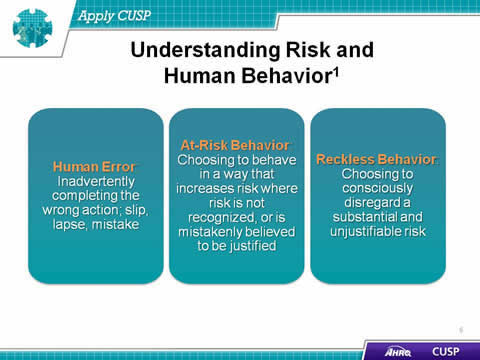
- Human Error:
- Inadvertently completing the wrong action; slip, lapse, mistake.
- At-Risk Behavior:
- Choosing to behave in a way that increases risk where risk is not recognized, or is mistakenly believed to be justified.
- Reckless Behavior:
- Choosing to consciously disregard a substantial and unjustifiable risk.
Slide 7. Managing Error and Risk1
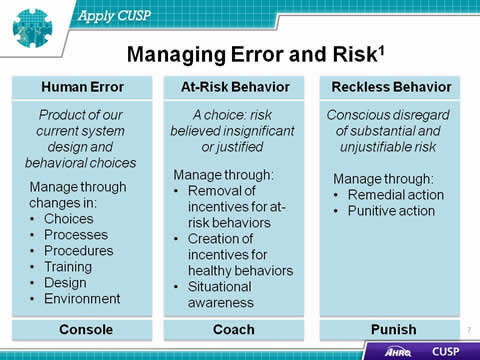
-
Human Error
Product of our current system design and behavioral choices.
Manage through changes in:
- Choices.
- Processes.
- Procedures.
- Training.
- Design.
- Environment.
Console
-
At-Risk Behavior
A choice: risk believed insignificant or justified.
Manage through:
- Removal of incentives for at-risk behaviors.
- Creation of incentives for healthy behaviors.
- Situational awareness.
Coach
-
Reckless Behavior
Conscious disregard of substantial and unjustifiable risk.
Manage through:
- Remedial action.
- Punitive action.
Punish
Slide 8. Systems and Behaviors Work Together To Improve Outcomes1
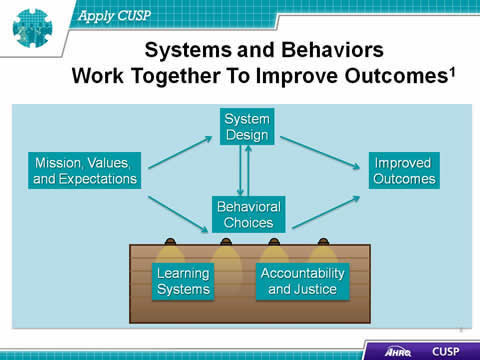
- System Design.
- Mission, Values, and Expectations.
- Behavioral Choices.
- Improved Outcomes.
- Learning Systems.
- Accountability and Justice.
Slide 9. Accountability
Vignette still.
Click to play.
Slide 10. Engineering System Design to Support Behavior Choices1
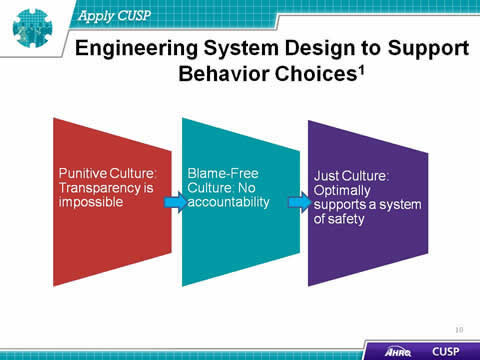
- Punitive Culture: Transparency is impossible.
- Blame-Free Culture: No accountability.
- Just Culture: Optimally supports a system of safety.
Slide 11. Leadership Team's Role in Applying Just Culture Principles
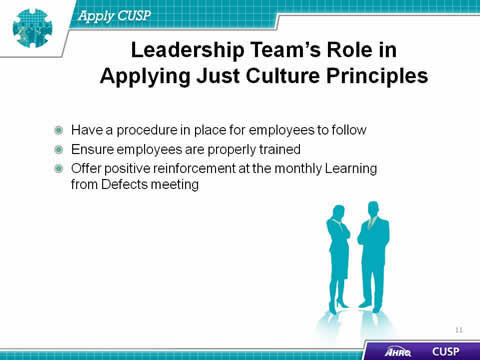
- Have a procedure in place for employees to follow.
- Ensure employees are properly trained.
- Offer positive reinforcement at the monthly Learning from Defects meeting.
Slide 12. Debrief on Accountability
Image: Vignette still.
Slide 13. CUSP Toolkit Modules
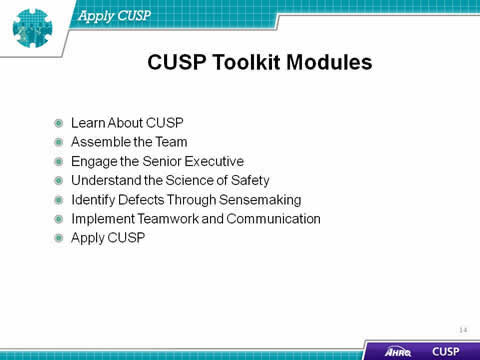
- Learn About CUSP.
- Assemble the Team.
- Engage the Senior Executive.
- Understand the Science of Safety.
- Identify Defects Through Sensemaking.
- Implement Teamwork and Communication.
- Apply CUSP.
Slide 14. CUSP Toolkit Review
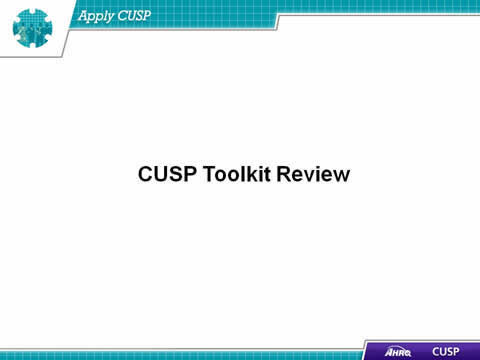
Slide 15. Assemble the Team
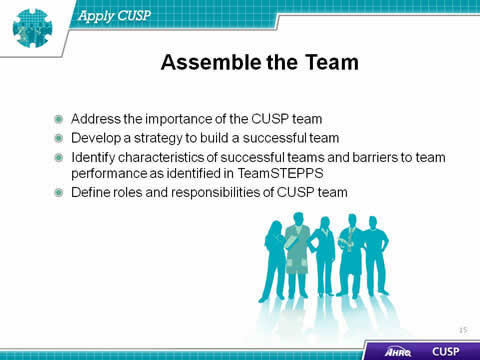
- Address the importance of the CUSP team.
- Develop a strategy to build a successful team.
- Identify characteristics of successful teams and barriers to team performance as identified in TeamSTEPPS.
- Define roles and responsibilities of CUSP team.
Slide 16. Keys to Assembling the Team
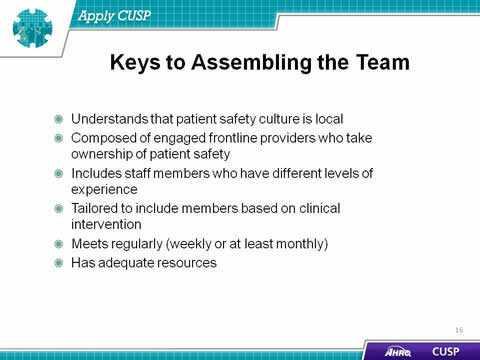
- Understands that patient safety culture is local.
- Composed of engaged frontline providers who take ownership of patient safety.
- Includes staff members who have different levels of experience.
- Tailored to include members based on clinical intervention.
- Meets regularly (weekly or at least monthly).
- Has adequate resources.
Slide 17. Engage the Senior Executive
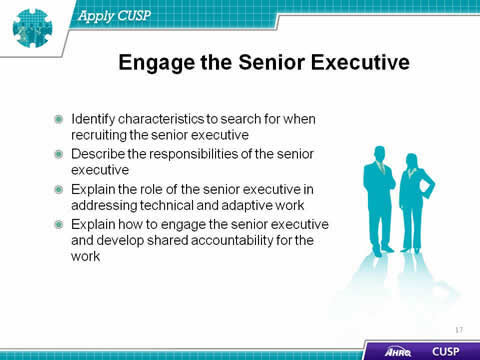
- Identify characteristics to search for when recruiting the senior executive.
- Describe the responsibilities of the senior executive.
- Explain the role of the senior executive in addressing technical and adaptive work.
- Explain how to engage the senior executive and develop shared accountability for the work.
Slide 18. Keys to Engaging the Senior Executive
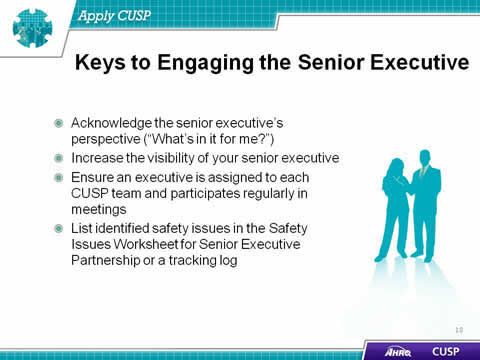
- Acknowledge the senior executive's perspective ("What's in it for me?").
- Increase the visibility of your senior executive.
- Ensure a senior executive is assigned to each CUSP team and participates regularly in meetings.
- List identified safety issues in the Safety Issues Worksheet for Senior Executive Partnership or a tracking log.
Slide 19. Understand the Science of Safety
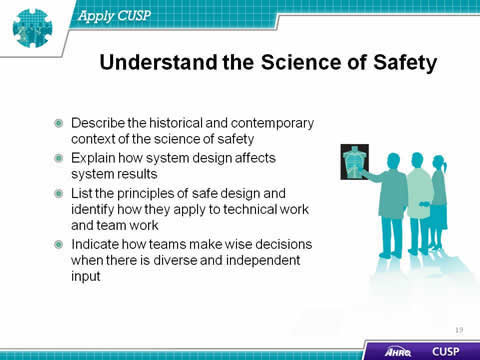
- Describe the historical and contemporary context of the science of safety.
- Explain how system design affects system results.
- List the principles of safe design and identify how they apply to technical work and team work.
- Indicate how teams make wise decisions when there is diverse and independent input.
Slide 20. Keys to Understanding the Science of Safety
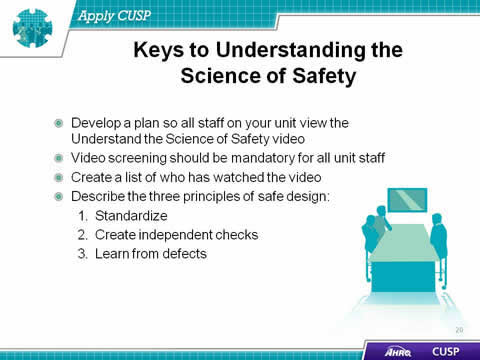
- Develop a plan so all staff on your unit view the Understand the Science of Safety video.
- Video screening should be mandatory for all unit staff.
- Create a list of who has watched the video.
- Describe the three principles of safe design:
Slide 21. Identify Defects Through Sensemaking
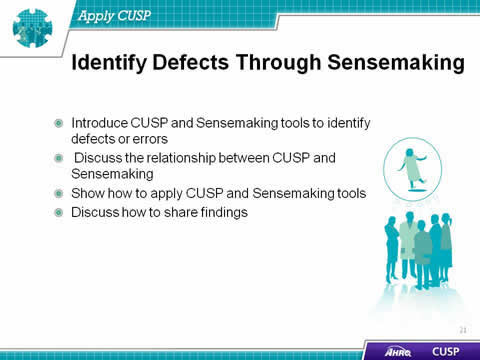
- Introduce CUSP and Sensemaking tools to identify defects or errors.
- Discuss the relationship between CUSP and Sensemaking.
- Show how to apply CUSP and Sensemaking tools.
- Discuss how to share findings.
Slide 22. Keys to Identifying Defects Through Sensemaking
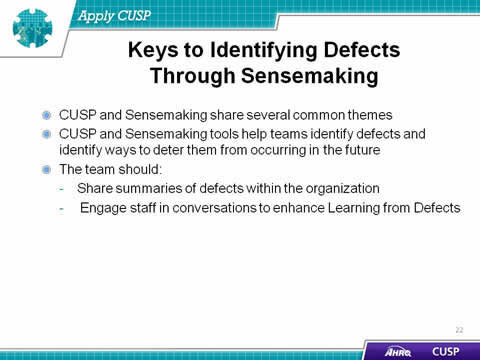
- CUSP and Sensemaking share several common themes.
- CUSP and Sensemaking tools help teams identify defects and identify ways to deter them from occurring in the future.
- The team should:
- Share summaries of defects within the organization.
- Engage staff in conversations to enhance Learning from Defects.
Slide 23. Implement Teamwork and Communication2
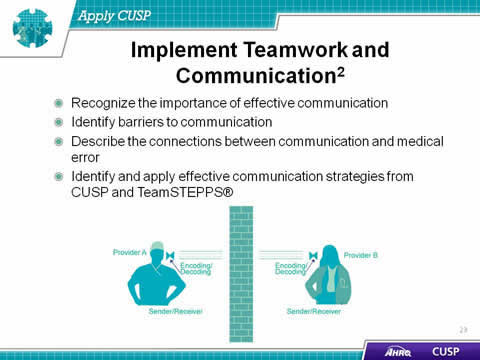
- Recognize the importance of effective communication.
- Identify barriers to communication.
- Describe the connections between communication and medical error.
- Identify and apply effective communication strategies from CUSP and TeamSTEPPS®.
Slide 24. The Keys to Effective Communication3
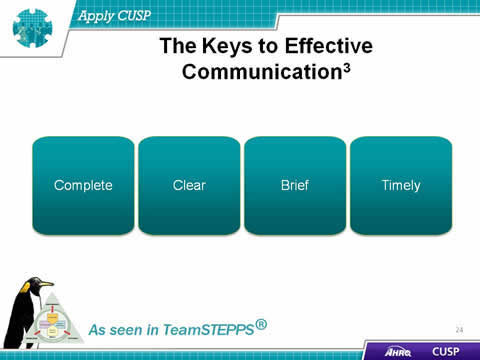
- Complete.
- Clear.
- Brief.
- Timely.
Slide 25. Summary
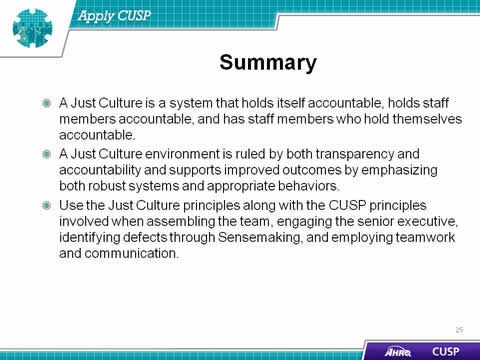
- A Just Culture is a system that holds itself accountable, holds staff members accountable, and has staff members who hold themselves accountable.
- A Just Culture environment is ruled by both transparency and accountability and supports improved outcomes by emphasizing both robust systems and appropriate behaviors.
- Use the Just Culture principles along with the CUSP principles involved when assembling the team, engaging the senior executive, identifying defects through Sensemaking, and employing teamwork and communication.
Slide 26. References
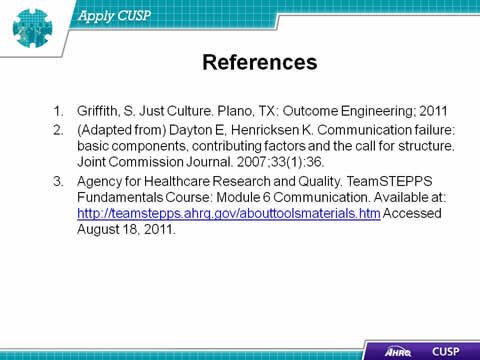
- Griffith, S. Just Culture. Plano, TX: Outcome Engineering; 2011.
- (Adapted from) Dayton E, Henricksen K. Communication failure: basic components, contributing factors and the call for structure. Joint Commission Journal 2007;33(1):36.
- Agency for Healthcare Research and Quality. TeamSTEPPS Fundamentals Course: Module 6 Communication. http://teamstepps.ahrq.gov/abouttoolsmaterials.htm Accessed August 18, 2011.




